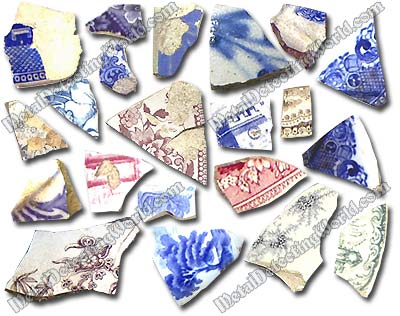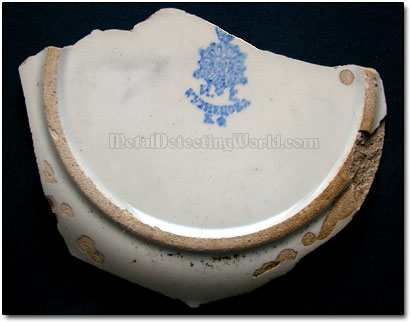Metal Detecting Research and Exploration - A Complete Guide, page 53
Footwork and Observation
POTTERY and CHINA SHARDS ON THE GROUND IN WOODED AREAS
(CONTINUED from Page 52)
Transferware was mass-produced by so called transfer printing - a decorative technique for plateware, in the 18th and 19th centuries. The transferware production technique was based on transferring the pattern, printed on tissue paper with wet ink, from a copper plate with engraved design to the ceramic surface. The ceramic is then fired in a low temperature kiln to fix the pattern. Transfer printing allowed hundreds of sets of plateware to be produced in a fraction of the time. The low cost of transferware allowed low- and middle-class families to have both utilitarian and decorative pieces for their homes.
Transferware was originally produced in a single color, with the favorite hues in blue, red, black, brown, purple and green. Brown color was common and inexpensive, while blue was the most sought after and expensive. The first transferware patterns were inspired by the Orient, and cobalt blue pieces exported from China were to designate wealth and high status.
Transferware Shards with Various Patterns Found at Hunt Sites in North-Eastern US

On page 60, I explained how to distinguish china shards of the pre-19th century plateware from the modern ones (19th-20th centuries). Just like shards unearthed in the farmlands, the china shards found in wooded areas not only indicate a location of former dwelling but also can help you date the hunt site.
Since the china shards of modern plateware often do not have crazing on glaze, you can still distinguish the 19th century shards from the 20th century ones by the following characteristics:
1) Presence of the same simple and one-colored pattern (similar to Transferware) that appears on most china shards.
2) Dark color of edges where plateware cracked, or where glaze is worn off.
3) Partial appearance of the manufacturer's coat of arms (if you are lucky to come across a central part of the plate's back side).
Manufacturer's Coat of Arms on Back of Plate's Fragment, ca. 19th Century, Dug at the Hunt Site

Spotting china shards and pottery in the fields is explained on page 59.